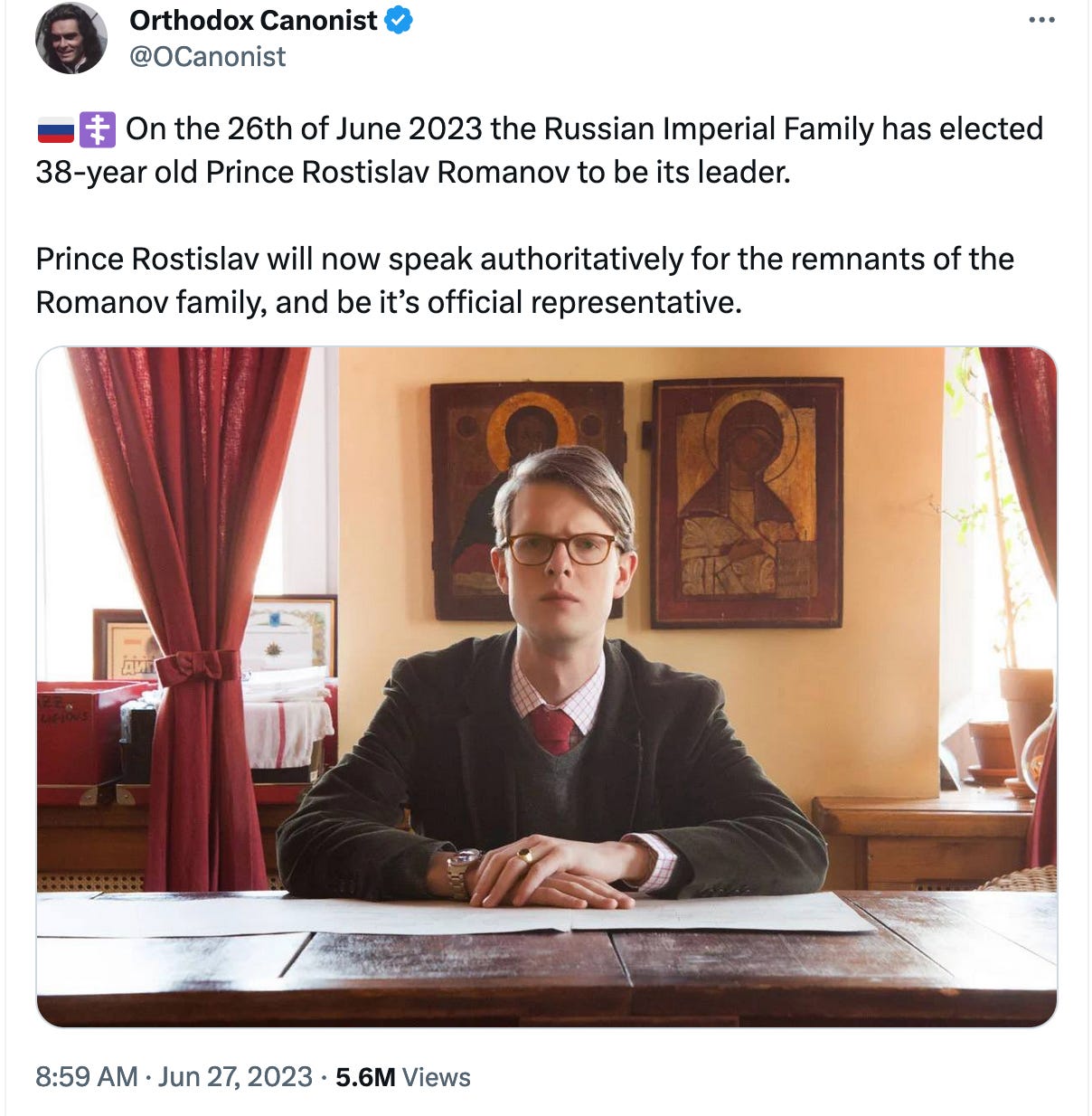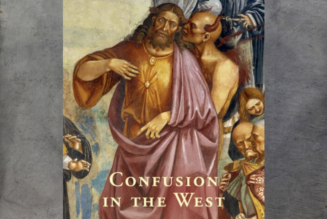Happy Friday friends,
Two quick bits of housekeeping before we get started:
Earlier this week I sent out a letter to our free readers, offering something of a rationale for where we are with The Pillar right now.
After some pretty important stories we’ve covered this week, and with more to come, it’s our best effort at articulating how we’re approaching the work we’re doing, and what we want this project to be for and within the life of the Church right now.
If you have a moment, please do read it.
The second thing is to remind you all, if you need reminding, that next week is the Fourth of July. So, JD will be on vacation next week, news permitting, and there will be no newsletter on Tuesday.
I’m looking forward to the Fourth. I had big plans for a “real” American summer, but they haven’t exactly panned out thus far.
The family signed up for the local Knights of Columbus pool, and I had soaring ambitions to work from the poolside most afternoons, diligently laboring under an umbrella while my daughter frolicked and my wife relaxed.
There would be, I imagined, hot dogs grilled in the picnic area just outside, and I’d probably round off the evening’s call sheet as the dull thwack of the bat drifted across from the softball diamond.
Instead, intermittent downpours have conspired to keep us indoors as often as not over the last week or so, and when the weather has cooperated, a fug of Canadian wildfire smog has left the neighborhood hazy and smelling faintly of burning tires.
I’m hoping the air will clear for the weekend, but we’ll see.
In the meantime, I’m fascinated by the deep emotional pull that cartoonish ideals of suburban American summer life have on me. We’ve been living in the U.S. for fully five years now, and I still get weird childhood flashbacks at the sound of a lawnmower firing up, or the dull tang of the smell of sunscreen.
I think one of the strongest mental images I carry from my early childhood on the North Shore of Chicago is of June evenings, when the adults would congregate on one or other front porch to drink beer and smoke Merits, while the kids ran across a block’s worth of front lawns.
When my wife and I started renting our current home, I remember looking up and down the street at the stoops and hoping that, even if we didn’t have children of our own, we’d be moving back into the best part of my childhood, somehow.
Of course, now we do have a kid of our own. And while she’s too small yet to have the run of the street, we have started to get to know some of the neighbors.
Last summer, the house directly across from us turned over and a family about our age moved in. They replaced some aggressively spandex-clad Whole Foods shoppers, and I hoped maybe the dad and I could share beers and power tools, as I remember my father doing with the other men on our street when I was a kid.
Mark* has proven to be the best kind of neighbor. His kids couldn’t be nicer and his wife couldn’t be kinder. They host regular barbecues in their backyard, to which we are always invited.
I don’t know Mark’s last name, and while I know where he works, I haven’t the faintest idea what he does there. He knows I have a kind of religious newsy website, but we don’t talk about work. We have never spoken a word about politics.
We have spoken long and in depth about the dark science of marinades as we stood over his grill. And we have debated the relative merits of different cast iron skillets, and swapped theories on bonfire architecture, along with bottles of homemade hooch.
Mark and I have shared cigarettes and split the bill on out-of-state (and very possibly illegal) fireworks for the Fourth of July.
In all of this, we’ve never had a tense moment or a cross word. Neither of us has ever tried to convince the other of anything more urgent than paying the extra $1 for smoked rather than normal paprika — it’s worth it.
We seem to have developed a weirdly sincere but limited friendship by unspoken mutual consent. I don’t know, because we don’t speak of such things, but I think we both appreciate the freedom to enjoy each other’s company without having to litigate the arguments which dominate so many of our conversations these days.
He keeps an eye on my house while I am out of town, and I on his. We see each other every day, but probably only exchange words once every ten. I doubt if Mark Lastnameunknown is my best friend, and it’s probably a reach to say we’re close. But he’s definitely a good summer friend. And I think we all need one of those.
Anyway, here’s the news.
—
The News
An expert hired by the state of Massachusetts has recommended that Theodore McCarrick be judged incompetent to stand trial on decades-old sexual assault charges against the former cardinal.
The expert’s findings were made public during a June 29 hearing in Dedham District Court.
While the recommendation does not itself mean that charges against McCarrick have been dismissed, a hearing scheduled for August could become one of the last times the disgraced former cardinal sees the inside of a courtroom.
You can read the whole story here.
—
The Vatican is facing backlash after it vetoed the appointment of a prominent German-speaking moral theologian as dean of an academic institution in northern Italy.
Many of Lintner’s publications and public statements have called for the Church to be open to the blessing of same-sex unions and a reimagining of Catholic teaching on sexual ethics and morality.
His defenders insist that “Lintner’s positions reflect a broad consensus within German-speaking moral theology.” I am not sure how much of a recommendation that is these days.
—
Speaking of German consensus, a record number of Catholics in the country said they left the Church last year — more than half a million of them.
There are some really interesting trends and data points behind the headline numbers though, and Luke Coppen has broken them down to bring you all the analysis you need, with our data guru Brendan Hodge serving up the best in interactive charts and maps to show you what’s happening, where.
—
Bishop Michael Olson of Fort Worth was in a Texas courtroom Tuesday, arguing that a civil court has no jurisdiction to hear a lawsuit filed by the Carmelite nuns of Arlington in the diocese.
The nuns are suing the bishop, saying that he defamed them, invaded their privacy, and stole information from their electronic devices, which were seized during a canonical investigation earlier this year.
During the hearing, the diocesan legal team played a lengthy recording, which The Pillar obtained, in which Mother Teresa Agnes Gerlach can be heard being questioned by Bishop Olson, conceding that while she had an inappropriate sexual relationship with a priest, and insisting that it was “all over the phone.”
For anyone who has been following the often acrimonious and always complicated back and forth between the diocese and the nuns in recent weeks, the recording answered a lot of questions about Bishop Olson’s reasons for intervening in the convent and ordering Gerlach out of office.
But it leaves unanswered a lot of other questions about what’s been going on in the Carmel, and what, exactly, Olson considers to be the canonical crime he’s been prosecuting.
We said from the beginning that there was a lot we didn’t know, and that people would regret jumping to conclusions about who is “right” and who is “wrong” here. While we now have a lot more information to flesh out the story, I think that’s still true.
(By the way, we accidentally emailed this report to you this week. Well, JD accidentally emailed it to you. He asked me to tell you he’s sorry about that — and I have made sure he is.)
—
We reported this week that opponents of a new liturgy in the Syro-Malabar Catholic Church have publicly burned copies of an ultimatum to adopt the change issued by an archbishop.
Despite a direct appeal from Pope Francis that they adopt the new mode, the vast majority of priests and lay people in the Ernakulam-Angamaly archdiocese reject the changes and want their preference for the liturgy facing the people to be recognized as a legitimate variant — and this has become one of the most long-running and combustible stories in the Church right now.
—
Shortly after the Vatican announced his resignation on Tuesday, Bishop Rick Stika, formerly of Knoxville, told a reporter in Tennessee that he is a victim of clerical sexual abuse.
The bishop made the statement to local media on Tuesday.
“I did the therapy, and I’m quite honest and open with it, so I see both sides of it. And no matter what anyone says, I would never tolerate sexual abuse of a minor or a vulnerable adult,” the bishop added.
Stika had not until recently made public any allegation that he had been sexually abused by a priest but he did do so first – it seems – in a charged exchange on Facebook last week with a man from his home diocese of St. Louis.
Stika claimed he “was sexually molested by John Murphy, a former priest of the Augustinian’s [sic] while I was a freshman at a seminary high school.”
The Pillar contacted the Augustinians’ Midwest Province to ask if Stika had made any previous allegation against Murphy to the order, but we haven’t heard back.
You can read the full report on what Bishop Stika has said here.
—
If you missed the story this week about a 40-year-old program begun by religious sisters in Australia, offering no-interest loans to those in need of financial reinforcements, I highly recommend it.
The program is now available to low-income residents throughout the entirety of Australia, as well as New Zealand, and the economic conditions being what they are, it’s proving very welcome indeed.
—
Bad art
It’s become something of a grim game for Catholics online to count the number of days official Vatican media accounts can go without featuring an image of the work of Marko Rupnik, the disgraced religious artist, priest, and former Jesuit.
They were at it again this week, tweeting and then deleting a Rupnik image of St. Irenaeus from their French language account.
Despite Rupnik’s public fall from grace and the stomach-churning details of his abuse of religious women, over decades, becoming known, his work is used so frequently by Vatican News that I have to wonder if they actually have images from any other artists in their files to use.
It certainly serves to keep alive the debate about what to do with Rupnik’s work, which does feature prominently in major churches and shrines around the world.
Of course, as many have pointed out, Rupnik is far from the first religious artist to have a dark side to his life. And I have seen and heard many arguments to say, essentially, that you have to be able to separate art from artist, and accept that even bad men can create beautiful things.
To a degree, I agree. Caravaggio’s “The Calling of St. Matthew” and “The Incredulity of St. Thomas” are some of my favorite works, and what I can take from them has nothing to do with the artist being a murderer.
And while Rupnik’s work has always struck me as simultaneously weird and cloying, I fully accept that many people find beauty in it.
But matters of aesthetics and personal preferences aside, Rupnik’s work is a particular case. And I think its defenders, both enthusiastic and reluctant, need to better engage with why Rupnik’s art is especially objectionable to so many.
One dedicated champion of keeping Rupnik’s work in place is Austen Ivereigh, the papal biographer and commentator, who is either a sort of quasi-official Vatican spokesman or just plays one on Twitter, I am never exactly sure which.
“Sacraments are ex opere operato; why not a great religious artist’s work?” Ivereigh said recently. “Rupnick stays on my wall; I don’t approve of what he has done, but his are works of grace, and I don’t want to reject grace.”
I’d take issue with this claim on a few levels.
The distinguishing factor in the Rupnik case is that he, according to several of his victims, used the artistic process of creating his work to groom and abuse women. The act of creating his work was bound up with the act of abusing his victims, sometimes in overtly blasphemous ways — they were not separate events but mutually dependent.
If Caravaggio cut a man’s throat in cold blood to use the corpse as a model for his “Beheading of St. John the Baptist,” I think most people would find that problematic. Maybe even Austen Ivereigh.
As such, I am not sure it’s possible to argue that Rupnik’s art, being the product of a process of sexual abuse, is a “work of grace,” unless you think that grace can be the product of an evil, even explicitly blasphemous act.
To consider Ivereigh’s sacramental analogy, a sinful, even abusive priest can surely validly perform the sacraments. To claim that the sinfulness of the minister ipso facto impedes the action of grace in the sacrament is, indeed, the heresy of Donatism.
But “ex opere operato” isn’t a magic phrase to wish away the all tragic reality of human perversity. A priest, like Rupnik, who attempts to absolve his own sexual partners does so invalidly (absent danger of death).
And while I have not myself seen a canonical case of a priest who attempted to confect the Eucharist while also engaged in the very act of sexually abusing a religious sister, I’d imagine that if it happened, there would at least be an argument for invalidity. The general sinful nature of the minister doesn’t invalidate a sacrament, but the intention not to do what the Church intends but instead to commit sacrilege might.
As a private matter and individual choice, I think Ivereigh can and should keep his Rupnik on the wall if it makes him happy. There’s no accounting for taste, after all.
But when it comes to official Vatican media, or the Church’s sacred spaces, I am not sure how defensible it is to hold up the rotten fruits, not just of an abusive man but of an abusive artistic process, for the edification of the faithful.
—
Russian icons
For a few days there last week it looked a lot like Russia might be about to tip over into a full-blown civil war. There was a mercenary army marching on Moscow, there were sandbags and checkpoints in the streets, and the government senior brass seemed to be MIA — a few still are.
Things seem to have stabilized for the moment, thankfully; while I wish the Russian government and its armed forces (national and mercenary) every possible setback and defeat in Ukraine, civil war in a nuclear nation is nobody’s road to peace.
But in the midst of the chaos, something fascinating rolled across my feed:
I have spent the last few days trying to figure out if this is some kind of impenetrable Tsarist in-joke, a plain hoax, or if the Romanov family really did make such a designation right at the moment it looked like Putin’s regime could actually be at risk.
I honestly can’t find out — though to be clear, Prince Rostislav is a real enough person, and real enough Romanov. As it happens, Rosti (as his family call him) was born just north of Chicago and spent the first years of his life not far from where I grew up, before he too moved to the U.K. as a young child.
While I’ve no information to suggest that his dad (also Prince Rostislav) and mine ever shared a smoke, or borrowed each other’s power tools, I can’t rule the possibility out, either.
But regardless of whether Misha (as the prince is also known) was formally designated head of the imperial dynasty last Friday, we’d be wrong, I think, to laugh off the fact that there are still Romanovs kicking around.
There is, as we have seen, a non-zero chance the Russian government could violently crater in on itself at short notice. In the event that it did, everyone — inside and outside of Russia — would be frantically searching for something that could unite the country before the chaos went global and/or nuclear. In those circumstances, bringing back the Tsar as a national figurehead over another stab at constitutional democracy wouldn’t be as crazy as it might sound.
Russia is a country with a long memory and a deep identity. “In the days of the Tsars” is still a common Russian idiom for the good old days, even if they weren’t that great.
Putin knows this, too. For all his Soviet strongman posturing and fondness for military parades in Red Square, when Vlad gives a speech, it isn’t a hammer and sickle he stands in front of, but a crowned imperial eagle.
The Tsar, too, was very much joined to the Russian Orthodox hierarchy, which has always deferred to the emperor — something Putin has readily used and abused to support his war, dragging the Church into disrepute with him.
But assuming for a second those Wagner Group troops did take Moscow, there’s no reason to think the Russian people would fancy one war criminal over another, or welcome a new slate of kleptocratic oligarchs to replace the old at the ballot box.
What the country would need is something to rally behind as it rebuilt its institutions and reasserted its identity — a national icon. If a 38-year-old landscape painter from Lake Forest seems an unlikely fit, I’d submit it might be better than any of the obvious alternatives.
Don’t get me wrong: I’m not one of those Americans who has an odd fascination with the dispossessed royal houses of Europe and spends their vacation days and dollars collecting selfies with minor Bourbons.
And I think it’s important to distinguish between royal families and families that happened to snag a crown for a few minutes.
The Habsburgs, for example, have produced saints and continue to show a commitment to public service throughout what used to be their empire; the House of Savoy, only the other hand, was only ever really a gang of Piedmontese chancers who rode south across Italy in the wake of a mercenary army for a grab at the Papal States — and they seem to spend most of their time and money these days suing each other.
But either way, I am an absolute pragmatist when it comes to political institutions. When I swore allegiance to the British crown I did so as an acknowledgment that the monarchy, the House of Windsor/Saxe-Coburg and Gotha, is what binds that country together, culturally, constitutionally, and historically.
And while Juan Carlos may be more famous for elephant hunting, mistresses, and money laundering these days, it shouldn’t be forgotten that the former Spanish king managed not long ago the incredibly fast and smooth transition of that country from fascist dictatorship to functioning democracy.
When you consider the enormous violent mess Russia could become all too easily, I’d argue that something as implausible as a Romanov restoration might be the best bet we have. We may not want them, but we just might need them one of these days.
See you next week,
Ed. Condon
Editor
The Pillar
Comments 17
Services Marketplace – Listings, Bookings & Reviews











